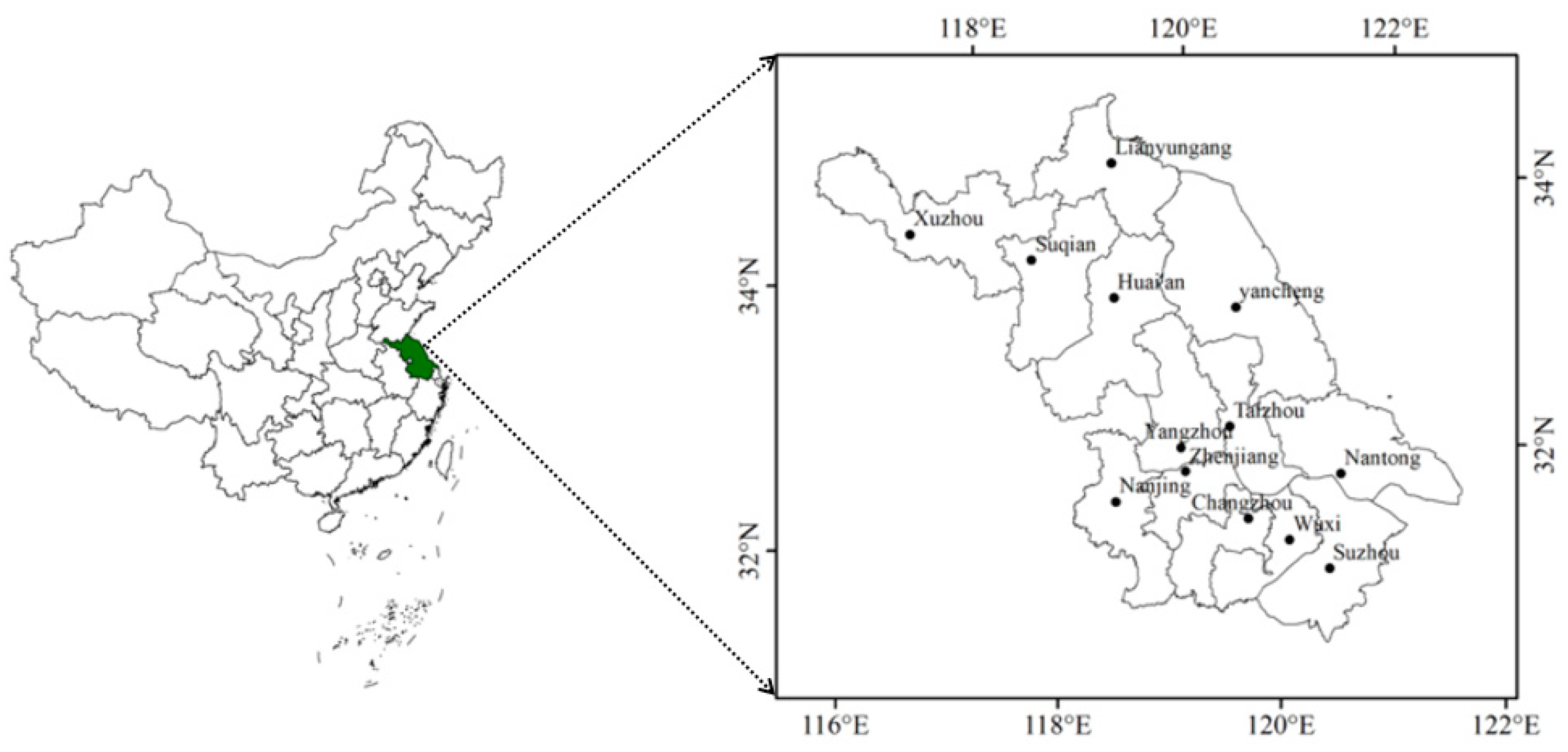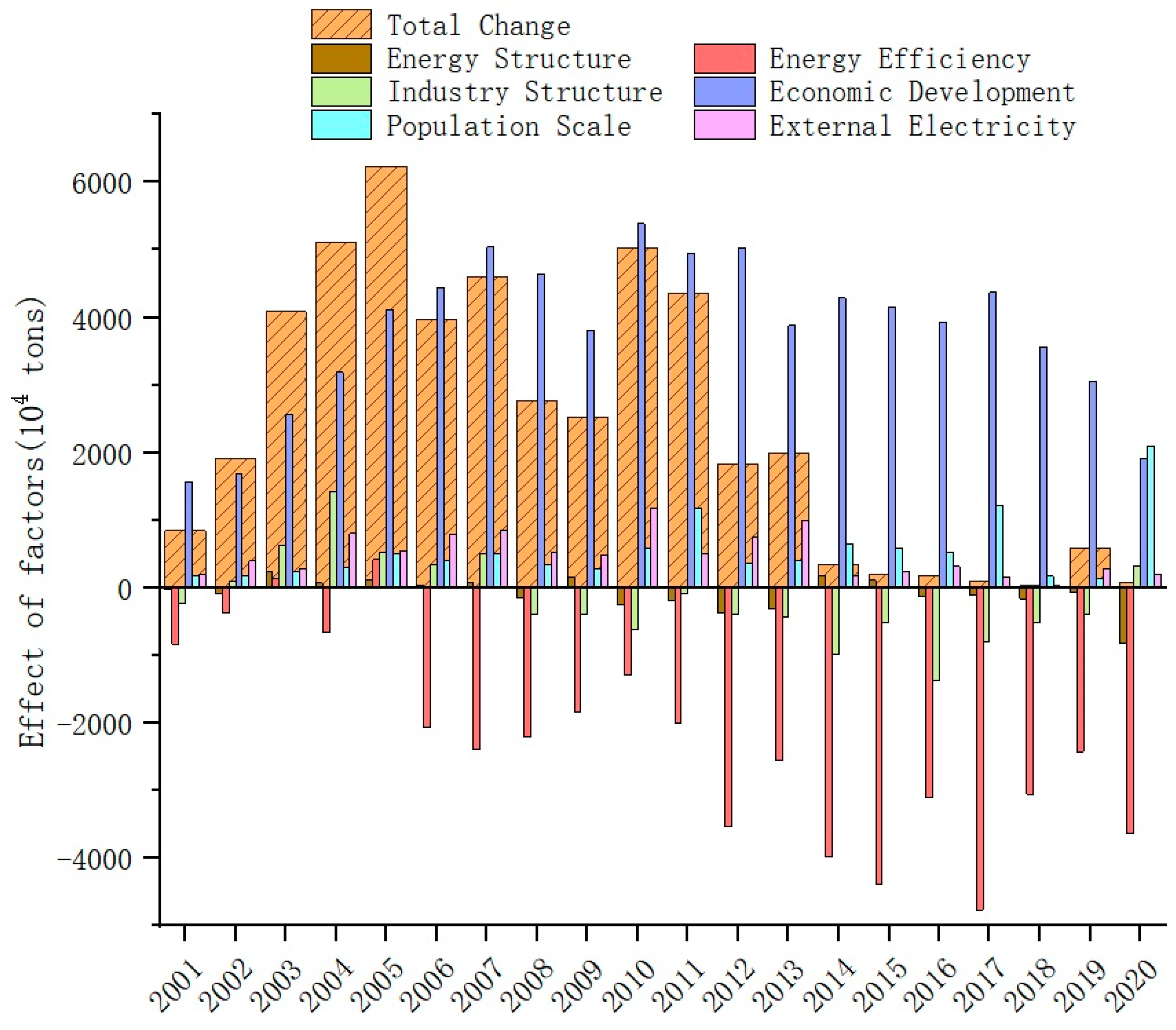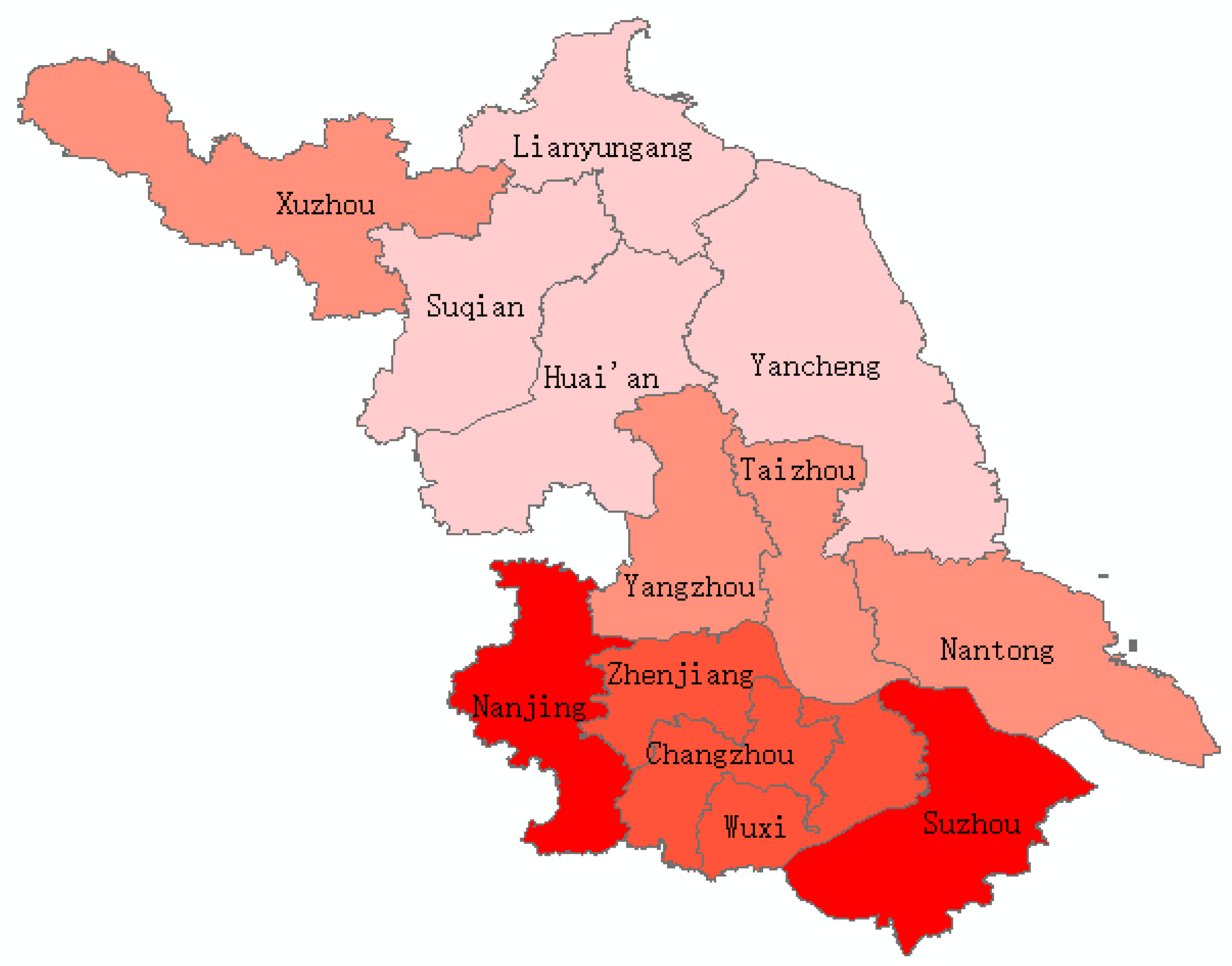Carbon Emissions Drivers and Reduction Strategies in Jiangsu Province
Abstract
:1. Introduction
1.1. Research Background
1.2. Literature Review
1.3. Paper Structure
2. Materials and Methods
2.1. Research Scheme
2.2. Sources of the Data
2.3. Carbon Emissions Calculation Model
- (1)
- Carbon emissions refer to CO2 emissions, excluding other greenhouse gas emissions;
- (2)
- The energy used to calculate carbon emissions mainly refers to nine types of energy, including raw coal and coke. Other types of energy are not included in the calculation range due to their relatively low usage and unavailability of data;
- (3)
- External electricity is included in the indirect carbon emissions of the inflow area. China has set carbon emissions factors for electricity in various regions, and Jiangsu Province belongs to the eastern region. Therefore, this value adopts the unified value of the eastern region.
2.4. The Logarithmic Mean Divisia Index (LMDI) Model
3. Results
3.1. Results from the Province’s Perspective
3.2. Results from the Cities’ Perspective
3.3. Carbon Reduction Strategy
4. Discussion
5. Conclusions and Policy Suggestions
5.1. Conclusions
- (1)
- The driving factors of carbon emissions in Jiangsu Province can be divided into two categories: carbon increase and carbon reduction. Among the factors contributing to carbon increase, economic development is the core factor leading to the growth of carbon emissions in Jiangsu Province. However, its influence is gradually weakening, meaning that the economic development mode of the area is moving towards the direction of high-quality development. The impact of external electricity on carbon emissions fluctuates greatly, but overall it still promotes carbon emissions. The population scale has the smallest promoting effect on carbon emissions, and the magnitude of change is also the smallest. The contribution of industrial structure and energy structure to reducing carbon emissions is smaller than that of energy efficiency factors. Although it is not very stable, its carbon reduction effect has become increasingly evident in recent years.
- (2)
- The driving factors of carbon emissions in various cities in Jiangsu Province have different roles and similarities. On the basis of a comprehensive consideration of uniformity, fairness, and flexibility, each category has its corresponding carbon reduction strategy. Nanjing and Suzhou need to adjust their industrial structure; Wuxi, Zhenjiang, and Xuzhou need to adjust their energy structure; Taizhou and Nantong need to adjust their energy efficiency; Changzhou, Yangzhou, and Huai’an need to adjust their energy and industrial structure at the same time; and the remaining cities, such as Lianyungang, need to adjust the three factors.
5.2. Policy Suggestions
Author Contributions
Funding
Institutional Review Board Statement
Informed Consent Statement
Data Availability Statement
Acknowledgments
Conflicts of Interest
References
- Jiang, L.; Hu, X.K.; Zhang, G.F.; Chen, Y.Q.; Zhong, H.L.; Shi, P.J. Carbon Emission Risk and Governance. Int. J. Disaster Risk Sci. 2022, 13, 249–260. [Google Scholar] [CrossRef]
- Chang, M.C. Carbon tax effect difference on net-zero carbon emissions target and social welfare level promotion. Carbon Manag. 2022, 13, 581–593. [Google Scholar] [CrossRef]
- Liu, L.Y.; Xun, L.L.; Wang, Z.Y.; Liu, H.W.; Huang, Y.; Bedra, K.B. Peak Carbon Dioxide Emissions Strategy Based on the Gray Model between Carbon Emissions and Urban Spatial Expansion for a Built-Up Area. Appl. Sci. 2023, 13, 187. [Google Scholar] [CrossRef]
- Yang, Z.K.; Zhang, M.M.; Liu, L.Y.; Zhou, D.Q. Can renewable energy investment reduce carbon dioxide emissions? Evidence from scale and structure. Energy Econ. 2022, 112, 106181. [Google Scholar] [CrossRef]
- Yang, W.; Zhang, M.; Long, H.S.; Yan, J. Thoughts on Teaching Reform of Resources Majors in Colleges and Universities under the Background of Carbon Peak and Carbon Neutralization-Taking Mineral Resources Exploration Course as an Example. Sustainability 2022, 14, 6523. [Google Scholar] [CrossRef]
- Qiu, X.Z. An empirical analysis of the influence of financial development on export trade: Evidence from Jiangsu province, China. Ekon. Istraz. 2022, 35, 1526–1541. [Google Scholar] [CrossRef]
- Luo, H.Y.; Lin, X.Y. Dynamic Analysis of Industrial Carbon Footprint and Carbon-Carrying Capacity of Zhejiang Province in China. Sustainability 2022, 14, 6824. [Google Scholar] [CrossRef]
- Ray, R.L.; Singh, V.P.; Singh, S.K.; Acharya, B.S.; He, Y.P. What is the impact of COVID-19 pandemic on global carbon emissions? Sci. Total Environ. 2022, 816, 151503. [Google Scholar] [CrossRef] [PubMed]
- Jiang, Y.; Zhou, Z.B.; Liu, C.J. Does economic policy uncertainty matter for carbon emission? Evidence from US sector level data. Environ. Sci. Pollut. Res. 2019, 26, 24380–24394. [Google Scholar] [CrossRef]
- Shao, M.T.; Dong, X.W.; Huang, H.T. Measurement of carbon emissions and responsibility sharing for the industrial sector in Zhejiang, China. Heliyon 2024, 10, e26505. [Google Scholar] [CrossRef]
- O’Dwyer, J.; Walshe, D.; Byrne, K.A. Wood waste decomposition in landfills: An assessment of current knowledge and implications for emissions reporting. Waste Manag. 2018, 73, 181–188. [Google Scholar] [CrossRef] [PubMed]
- Wang, X.; Li, L.; Zhao, F.S. Decomposition Analysis of CO2 Emissions in Northeast China: Insights From Investment Factors. Front. Energy Res. 2021, 9, 777290. [Google Scholar] [CrossRef]
- Lach, L. Optimization based structural decomposition analysis as a tool for supporting environmental policymaking. Energy Econ. 2022, 115, 106332. [Google Scholar] [CrossRef]
- Lian, L.; Lin, J.Y.; Yao, R.H.; Tian, W. The CO2 emission changes in China’s transportation sector during 1992–2015: A structural decomposition analysis. Environ. Sci. Pollut. Res. 2020, 27, 9085–9098. [Google Scholar] [CrossRef] [PubMed]
- Zhang, Y.G. Supply-side structural effect on carbon emissions in China. Energy Econ. 2010, 32, 186–193. [Google Scholar] [CrossRef]
- Ang, B.W.; Huang, H.C.; Mu, A.R. Properties and linkages of some index decomposition analysis methods. Energy Policy 2009, 37, 4624–4632. [Google Scholar] [CrossRef]
- Karakaya, E.; Bostan, A.; Ozcag, M. Decomposition and decoupling analysis of energy-related carbon emissions in Turkey. Environ. Sci. Pollut. Res. 2019, 26, 32080–32091. [Google Scholar] [CrossRef] [PubMed]
- Faridzad, A.; Ghadim, M.G. CO2 intensity decomposition analysis in the Netherlands’ manufacturing industry: An application of monetary and physical indicators. Environ. Dev. Sustain. 2023, 25, 8799–8817. [Google Scholar] [CrossRef]
- Ang, B.W. Decomposition analysis for policymaking in energy: Which is the preferred method? Energy Policy 2004, 32, 1131–1139. [Google Scholar] [CrossRef]
- Liu, L.C.; Fan, Y.; Wu, G.; Wei, Y.M. Using LMDI method to analyzed the change of China’s industrial CO2 emissions from final fuel use: An empirical analysis. Energy Policy 2007, 35, 5892–5900. [Google Scholar] [CrossRef]
- De Oliveira-De Jesus, P.M. Effect of generation capacity factors on carbon emission intensity of electricity of Latin America & the Caribbean, a temporal IDA-LMDI analysis. Renew. Sustain. Energ. Rev. 2019, 101, 516–526. [Google Scholar] [CrossRef]
- Chen, J.D.; Gao, M.; Li, D.; Song, M.L.; Xie, Q.J.; Zhou, J.X. Extended Yearly LMDI Approaches: A Case Study of Energy Consumption. Math. Probl. Eng. 2020, 2020, 9207896. [Google Scholar] [CrossRef]
- Meng, Z.S.; Wang, H.; Wang, B.N. Empirical Analysis of Carbon Emission Accounting and Influencing Factors of Energy Consumption in China. Int. J. Environ. Res. Public Health 2018, 15, 2467. [Google Scholar] [CrossRef] [PubMed]
- Xiang, X.W.; Ma, X.; Ma, Z.L.; Ma, M.D.; Cai, W.G. Python-LMDI: A Tool for Index Decomposition Analysis of Building Carbon Emissions. Buildings 2022, 12, 83. [Google Scholar] [CrossRef]
- Quan, C.G.; Cheng, X.J.; Yu, S.S.; Ye, X. Analysis on the in fluencing factors of carbon emission in China’s logistics industry based on LMDI method. Sci. Total Environ. 2020, 734, 138473. [Google Scholar] [CrossRef] [PubMed]
- Peng, D.; Liu, H.B. Measurement and Driving Factors of Carbon Emissions from Coal Consumption in China Based on the Kaya-LMDI Model. Energies 2023, 16, 439. [Google Scholar] [CrossRef]
- Wang, M.; Zhu, C.Z.; Cheng, Y.; Du, W.B.; Dong, S. The influencing factors of carbon emissions in the railway transportation industry based on extended LMDI decomposition method: Evidence from the BRIC countries. Environ. Sci. Pollut. Res. 2023, 30, 15490–15504. [Google Scholar] [CrossRef]
- Chen, S.Q.; Long, H.H.; Chen, B.; Feng, K.S.; Hubacek, K. Urban carbon footprints across scale: Important considerations for choosing system boundaries. Appl. Energy 2020, 259, 114201. [Google Scholar] [CrossRef]
- Fan, T.J.; Luo, R.L.; Xia, H.Y.; Li, X.P. Using LMDI method to analyze the influencing factors of carbon emissions in China’s petrochemical industries. Nat. Hazards 2015, 75, S319–S332. [Google Scholar] [CrossRef]
- Wang, L. Assessment of land use change and carbon emission: A Log Mean Divisa (LMDI) approach. Heliyon 2024, 10, e25669. [Google Scholar] [CrossRef]
- He, Y.; Xing, Y.T.; Zeng, X.C.; Ji, Y.J.; Hou, H.M.; Zhang, Y.; Zhu, Z. Factors influencing carbon emissions from China’s electricity industry: Analysis using the combination of LMDI and K-means clustering. Environ. Impact Assess. Rev. 2022, 93, 106724. [Google Scholar] [CrossRef]
- Lin, Z.R.; Wang, H.; Li, W.; Chen, M. Impact of Green Finance on Carbon Emissions Based on a Two-Stage LMDI Decomposition Method. Sustainability 2023, 15, 12808. [Google Scholar] [CrossRef]
- Ang, B.W. LMDI decomposition approach: A guide for implementation. Energy Policy 2015, 86, 233–238. [Google Scholar] [CrossRef]
- Eeckhout, L. Kaya for Computer Architects: Toward Sustainable Computer Systems. IEEE Micro 2023, 43, 9–18. [Google Scholar] [CrossRef]
- Liu, H.X.; Zhang, J.; Yuan, J.H. Can China achieve its climate pledge: A multi-scenario simulation of China’s energy-related CO2 emission pathways based on Kaya identity. Environ. Sci. Pollut. Res. 2022, 29, 74480–74499. [Google Scholar] [CrossRef] [PubMed]
- Hua, F.; Alharthi, M.; Yin, W.H.; Saeed, M.; Ahmad, I.; Ali, S.A. Carbon Emissions and Socioeconomic Drivers of Climate Change: Empirical Evidence from the Logarithmic Mean Divisia Index (LMDI) Base Model for China. Sustainability 2022, 14, 2214. [Google Scholar] [CrossRef]
- Liu, K.; Xie, X.Y.; Zhao, M.X.; Zhou, Q. Carbon Emissions in the Yellow River Basin: Analysis of Spatiotemporal Evolution Characteristics and Influencing Factors Based on a Logarithmic Mean Divisia Index (LMDI) Decomposition Method. Sustainability 2022, 14, 9524. [Google Scholar] [CrossRef]
- Golas, Z. Changes in Energy-Related Carbon Dioxide Emissions of the Agricultural Sector in Poland from 2000 to 2019. Energies 2022, 15, 4264. [Google Scholar] [CrossRef]
- Wang, P.; Wu, P.; Song, Y.Z.; Hampson, K.; Zhong, Y. A novel spatio-temporally stratified heterogeneity model for identifying factors influencing carbon emissions. Energy Build. 2023, 280, 112714. [Google Scholar] [CrossRef]
- Falahatkar, S.; Mousavi, S.M.; Farajzadeh, M. Spatial and temporal distribution of carbon dioxide gas using GOSAT data over IRAN. Environ. Monit. Assess. 2017, 189, 627, Erratum in Environ. Monit. Assess. 2018, 190, 98. [Google Scholar] [CrossRef]
- Yang, J.B.; Ding, H. A Quantitative Assessment of Sustainable Development Based on Relative Resource Carrying Capacity in Jiangsu Province of China. Int. J. Environ. Res. Public Health 2018, 15, 2786. [Google Scholar] [CrossRef] [PubMed]
- Kong, H.J.; Shi, L.F.; Da, D.; Li, Z.J.; Tang, D.C.; Xing, W. Simulation of China’s Carbon Emission based on Influencing Factors. Energies 2022, 15, 3272. [Google Scholar] [CrossRef]
- Wu, X.Y.; Xu, C.X.; Ma, T.L.; Xu, J.R.; Zhang, C.J. Carbon emission of China’s power industry: Driving factors and emission reduction path. Environ. Sci. Pollut. Res. 2022, 29, 78345–78360. [Google Scholar] [CrossRef] [PubMed]
- Zhang, H.N.; Zhang, X.P.; Yuan, J.H. Driving forces of carbon emissions in China: A provincial analysis. Environ. Sci. Pollut. Res. 2021, 28, 21455–21470. [Google Scholar] [CrossRef] [PubMed]
- MacDonald, A.E.; Clack, C.T.M.; Alexander, A.; Dunbar, A.; Wilczak, J.; Xie, Y.F. Future cost-competitive electricity systems and their impact on US CO2 emissions. Nat. Clim. Chang. 2016, 6, 526–531. [Google Scholar] [CrossRef]
- Jin, J.L.; Zhou, P.; Li, C.Y.; Guo, X.J.; Zhang, M.M. Low-carbon power dispatch with wind power based on carbon trading mechanism. Energy 2019, 170, 250–260. [Google Scholar] [CrossRef]
- Zhang, Y.; Yu, Z.; Zhang, J. Analysis of carbon emission performance and regional differences in China’s eight economic regions: Based on the super-efficiency SBM model and the Theil index. PLoS ONE 2021, 16, e0250994. [Google Scholar] [CrossRef]



| Energy Type | Raw Coal | Coke | Crude Oil | Gasoline | Kerosene | Diesel | Liquefied Petroleum Gas | Fuel Oil |
|---|---|---|---|---|---|---|---|---|
| Carbon emissions index | 1.9003 | 2.8604 | 3.02 | 2.9251 | 3.0179 | 3.0959 | 3.1013 | 3.1705 |
| City | Industrial Structure | Energy Structure | Energy Efficiency | Economic Development | Population Scale | External Electricity |
|---|---|---|---|---|---|---|
| Nanjing | −59.28% | −34.82% | −617.45% | 657.07% | 9.73% | 134.74% |
| Suzhou | −62.83% | −42.25% | −837.03% | 916.14% | 1.14% | 124.82% |
| Wuxi | −45.95% | −9.99% | −102.30% | 214.60% | 0.60% | 43.05% |
| Zhenjiang | −52.22% | −9.25% | −226.72% | 318.36% | −8.70% | 78.54% |
| Changzhou | −3.86% | −1.77% | −244.63% | 316.85% | 28.88% | 4.53% |
| Yangzhou | −4.33% | −2.20% | −257.51% | 322.67% | 19.14% | 22.23% |
| Taizhou | −30.51% | −8.48% | −96.44% | 161.01% | 27.03% | 47.40% |
| Nantong | −18.05% | −3.93% | −137.45% | 233.68% | 7.10% | 18.64% |
| Xuzhou | −11.53% | 4.52% | −101.07% | 180.02% | 7.00% | 21.06% |
| Huai’an | 36.72% | 11.47% | −293.61% | 339.78% | −16.50% | 10.85% |
| Lianyungang | 4.73% | 4.93% | −66.58% | 138.36% | −0.05% | 18.62% |
| Suqian | 17.15% | 3.17% | −69.87% | 124.14% | −4.21% | 29.62% |
| Yancheng | 6.26% | 5.63% | −55.02% | 115.26% | −4.99% | 32.86% |
| Type | City | Characteristic | Carbon Emissions Reduction Policies |
|---|---|---|---|
| I | Nanjing Suzhou | Ideal carbon reduction effects | Focus on industry structure, develop high-tech industries |
| Wuxi Zhenjiang | Focus on energy structure, use clean energy | ||
| II | Changzhou Yangzhou | Good carbon reduction effects; have a lot of room for emissions reduction | Focus on industry and energy structure |
| Taizhou Nantong | Focus on energy efficiency | ||
| III | Xuzhou | Least emissions reduction effects | Optimize energy consumption structure, develop wind power |
| Huai’an | Optimize energy and industry structure, develop hydroelectric power | ||
| Lianyungang Suqian Yancheng | Focus on industry structure, energy structure, and energy efficiency |
Disclaimer/Publisher’s Note: The statements, opinions and data contained in all publications are solely those of the individual author(s) and contributor(s) and not of MDPI and/or the editor(s). MDPI and/or the editor(s) disclaim responsibility for any injury to people or property resulting from any ideas, methods, instructions or products referred to in the content. |
© 2024 by the authors. Licensee MDPI, Basel, Switzerland. This article is an open access article distributed under the terms and conditions of the Creative Commons Attribution (CC BY) license (https://creativecommons.org/licenses/by/4.0/).
Share and Cite
Deng, J.; Liu, C.; Mao, C. Carbon Emissions Drivers and Reduction Strategies in Jiangsu Province. Sustainability 2024, 16, 5276. https://doi.org/10.3390/su16135276
Deng J, Liu C, Mao C. Carbon Emissions Drivers and Reduction Strategies in Jiangsu Province. Sustainability. 2024; 16(13):5276. https://doi.org/10.3390/su16135276
Chicago/Turabian StyleDeng, Jiangao, Cheng Liu, and Chunmei Mao. 2024. "Carbon Emissions Drivers and Reduction Strategies in Jiangsu Province" Sustainability 16, no. 13: 5276. https://doi.org/10.3390/su16135276





